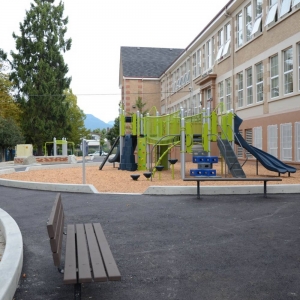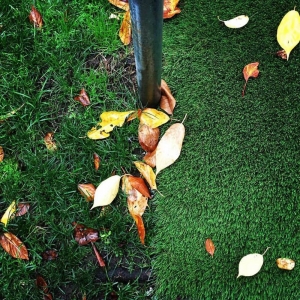This section is meant to provide a basic introduction to the wide range of materials that can be used in the design of school grounds. It is by no means an exhaustive list, but may help to inspire you as you begin planning out your project. For more information on where these materials can be used, please visit the elements section.
Asphalt
The school ground classic, asphalt is inexpensive, durable, and low maintenance. It can also be very dull. Spice things up by using asphalt to form mounds, adding some paint for a splash of colour, or cutting away portions of the asphalt and filling with other materials.
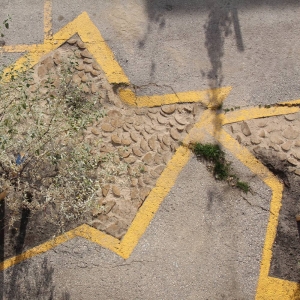 Asphalt cut outs at Folly Forest
(Folly Forest | Straub Thurmayr Landscape Architects and Urban Designers)
Asphalt cut outs at Folly Forest
(Folly Forest | Straub Thurmayr Landscape Architects and Urban Designers)
Brick
A classic school material, brick can be deployed as a ground surfacing material, or used to construct vertical elements. It comes in a wide variety of colours, and can be recycled from schools that are being demolished. Brick also lends itself to the creation of a “legacy wall.”
 Wall with inscribed legacy bricks
(Laura Secord Elementary School | Jonathan Losee Ltd. Landscape Architecture)
Wall with inscribed legacy bricks
(Laura Secord Elementary School | Jonathan Losee Ltd. Landscape Architecture)
Composite Decking
Composite board (comprised of wood and plastic) products are a durable alternative to wood decking that work well in play environments. It comes in a wide variety of colours, is fade-resistant, and low-maintenance.
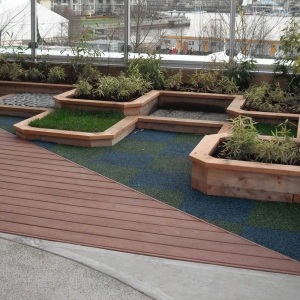 Composite decking beside tiered planters
(Sea Star Children's Centre | PWL Partnership Landscape Architects Inc.)
Composite decking beside tiered planters
(Sea Star Children's Centre | PWL Partnership Landscape Architects Inc.)
 Circular forms made with composite decking
(Sea Star Children's Centre | PWL Partnership Landscape Architects Inc.)
Circular forms made with composite decking
(Sea Star Children's Centre | PWL Partnership Landscape Architects Inc.)
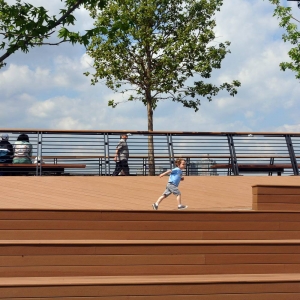 Trex terraces at Race Street Pier
(Race Street Pier | James Corner Field Operations | Image: Edward Savaria Jr and Suzanne Savaria)
Trex terraces at Race Street Pier
(Race Street Pier | James Corner Field Operations | Image: Edward Savaria Jr and Suzanne Savaria)
Concrete
Concrete is a versatile design material. While it can be expensive, it makes up for the initial cost since it is low maintenance and durable. It can come in a variety of colours, and can be finished in different ways, or even have other materials mixed in. It can also be formed in many different ways, and can be used to create pre-cast pavers.
Glass/Ceramic
While not suited to areas with high traffic, glass can still be incorporated into a school ground design. Colourful glass panels can be etched, and glass tiles or blocks can be used to add an interesting transparent dynamic to walls and walking surfaces. A combination of glass and ceramic tiles can be used to create exciting mosaics – a great opportunity for students to contribute to the design of their own school ground.
Grass and Artificial Turf
Grass surfaces provide a soft, comfortable space to relax. However, grass is generally high-maintenance and should not be used for high traffic areas. Artificial turf provides a grass alternative for playing fields and high-traffic zones, and also comes in a variety of colours.
Metal
Metal can be used throughout the play environment in different ways. A great deal of play equipment is made from metal, which is durable and low maintenance. Metal can also be used as an accent, and stainless steel is commonly used for water play elements. Different finishes can be applied to metal – from the rust colour of corten steel to the brilliant shades of powder coating.
Plants
Plants are easily one of the most important materials to be considered in the design of a schoolyard. Trees provide shady respite from active play, and the seasonal change of plants provides a learning opportunity. Plants are a sensory experience, offering up different colours, textures, and scents. For more on plants and play, click here.
 Planting around a slide
(Terra Nova Play Experience | HAPA Collaborative | Image: Joshua Dool Photography)
Planting around a slide
(Terra Nova Play Experience | HAPA Collaborative | Image: Joshua Dool Photography)
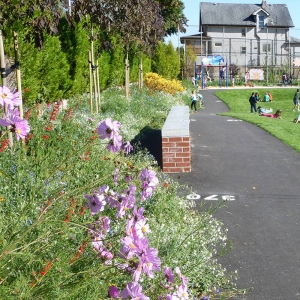 Meadow planting at Laura Secord Elementary, Vancouver
(Laura Secord Elementary School | Jonathan Losee Ltd. Landscape Architecture)
Meadow planting at Laura Secord Elementary, Vancouver
(Laura Secord Elementary School | Jonathan Losee Ltd. Landscape Architecture)
Plastic
Plastics are durable, high performance, easy to handle, and low cost. They can also achieve different levels of transparency and a wide range of colours. While a shift away from plastic play equipment is advisable, plastics can still play an interesting role in design projects. One of the biggest advantages of plastics is their ability to be shaped into limitless forms.
 Plastic blocks at playground for the blind and visually impaired
(Playgrounds at Saxon Rehab Center | Rehwaldt Landscape Architects)
Plastic blocks at playground for the blind and visually impaired
(Playgrounds at Saxon Rehab Center | Rehwaldt Landscape Architects)
Recycled/Unusual Materials
Unconventional materials can sometimes make for the most interesting play elements. Recycled tractor tires become sand boxes, former residential doors become doors to imaginary worlds, and driftwood takes on a new life.
 Recycled doors incorporated into play structure
(Kilburn Grange Adventure Play Park | Erect Architecture | Image: David Grandorge)
Recycled doors incorporated into play structure
(Kilburn Grange Adventure Play Park | Erect Architecture | Image: David Grandorge)
 Repurposed tractor tires as sandboxes
(Grimston Park Playground | Richard Findlay Landscape Architect Inc.)
Repurposed tractor tires as sandboxes
(Grimston Park Playground | Richard Findlay Landscape Architect Inc.)
Rope
Net climbing structures provide a fun physical challenge, and are a popular playground element. Nylon rope is a durable material that comes in a wide variety of exciting colours, and can even be patterned.
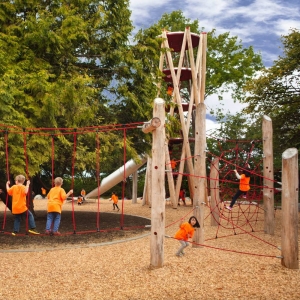 Red rope connecting play structures at Terra Nova Play Experience
(Terra Nova Play Experience | HAPA Collaborative | Image: Joshua Dool Photography)
Red rope connecting play structures at Terra Nova Play Experience
(Terra Nova Play Experience | HAPA Collaborative | Image: Joshua Dool Photography)
 Red rope climbers
(John Lawson Park Playground and Splash Pad | Richard Findlay Landscape Architect Inc.)
Red rope climbers
(John Lawson Park Playground and Splash Pad | Richard Findlay Landscape Architect Inc.)
Rubber
Rubber is common in play environments as a fall-protective surface material (poured rubber), and as an element of play equipment. This material is durable, low-maintenance, and comes from a recycled product. It also comes in an endless array of colours and can be poured into all kinds of shapes and patterns.
Sand
Sand can function as both a soft fall surface, and a play element that can be manipulated. It is especially fun in play environments that include water. Sand can also have colour baked into it – red sand anyone?! This colour is stable and will not transfer to skin or clothing.
 Sand and water mix at Garden City Play Environment
(Garden City Play Environment | space2place design inc.)
Sand and water mix at Garden City Play Environment
(Garden City Play Environment | space2place design inc.)
Stone
Stone can be used to provide a ground surface, a play element, or a vertical wall. It comes in all kinds of finishes and forms. Rough boulders can be incorporated throughout the play environment, creating a natural play and seating element. Crushed stone products such as pea gravel can form a walking surface. Stone pavers may also be used as a surfacing material. Stacked stone or basalt columns can form walls.
Wood
There are several ways wood can be incorporated into a play or outdoor learning environment including as safety surfacing (in the form of wood mulch) and play equipment. Treated wood is fire-resistant and durable and allows for the creation of a more naturalistic environment.



